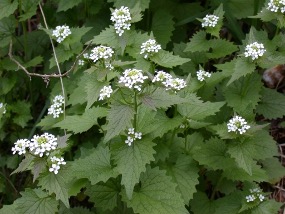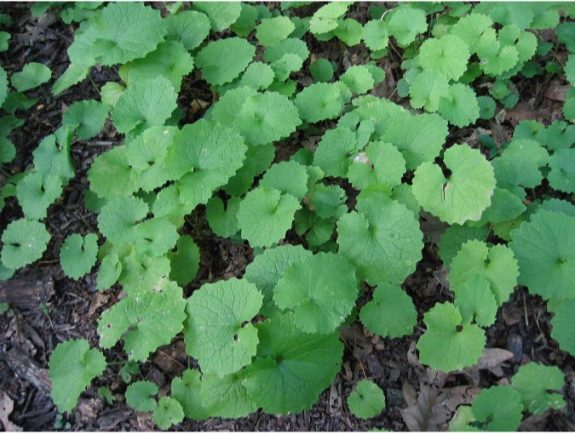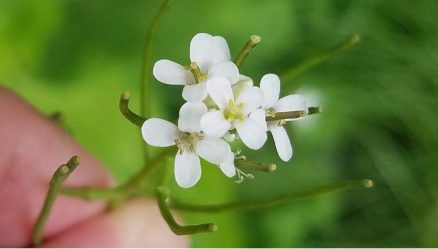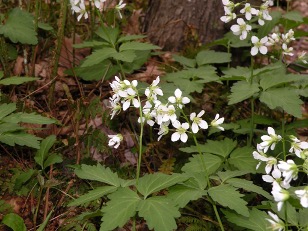
Garlic mustard is a very nasty invasive plant that stinks like garlic when crushed. I call it nasty because this biennial invasive can destroy our native plants and even trees. Many native wildflowers that bloom in the spring (like wild ginger, bloodroot, Dutchman’s breeches, hepatica, toothwort, and trillium) are in danger when garlic mustard moves into the neighborhood.
Once garlic mustard gets a roothold in your yard, you can kiss native plants goodbye. It kills natives by aggressively monopolizing light, moisture, nutrients and soil. It even secretes chemicals that kill soil organisms other plants need to grow. To make matters worse, wildlife species dependent on native plants for pollen, nectar, fruits, seeds and roots are deprived of essential food sources when garlic mustard is on the rampage.

Garlic mustard first appears in spring as an apparently harmless rosette of green heart-shaped leaves close to the ground. The rosettes remain green through the winter, so if you missed any in the spring, they are easy to spot when you make weed rounds. (you do make weed rounds, don’t you?) Hand-pull those little devils as soon as you see them. And get the entire root, because new plants can grow from root fragments.

If you don’t pull up the rosettes this winter, next spring you’ll find the plant growing two to three feet tall with clusters of small white flowers. Remove them as soon as you see them. Do not put them in your compost pile. The flowers can still go to seed even after the plant is removed from the ground.
In May, slender seed pods develop, which become shiny black when they mature. Don’t miss your second chance–get those pods before they mature and bag them so the seeds can’t escape and wreak more havoc. Here’s the really bad news—just one plant can produce thousands of seeds, which can remain viable for five years. What a nightmare.
By late June, when most of the garlic mustard plants have died, you’ll see their erect stalks containing dry, pale brown seedpods getting ready to blast your yard with new plants. Take this last opportunity to get rid of them by hand-pulling the plants. Don’t let them go to seed!
For larger infestations of garlic mustard, or when hand-pulling is not practical, cut flowering stems at ground level to prevent seed production. If you cut the stems higher, they’ll just grow back and flower again. And since the plant is a biennial, it won’t come back next year (hopefully).
For very heavy infestations, some people use a systemic herbicide (that kills EVERYTHING it’s sprayed on, including natives). That is not a good option. I hand-pull the plants, as do countless volunteers who help remove garlic mustard from public spaces.

When eliminating garlic mustard from your property, make sure you have the right plant. Toothwort and early saxifrage may be mistaken for garlic mustard. Garlic mustard flower has four petals in the shape of a cross and its coarsely toothed. Leaves smell like garlic when crushed. None of the look-alikes have that garlic smell.
Get to know garlic mustard—and then eliminate it from your property. And tell your neighbors about it so they can be on guard for this interloper.
Need more info? Check out this excellent video on garlic mustard.

Leave a Reply